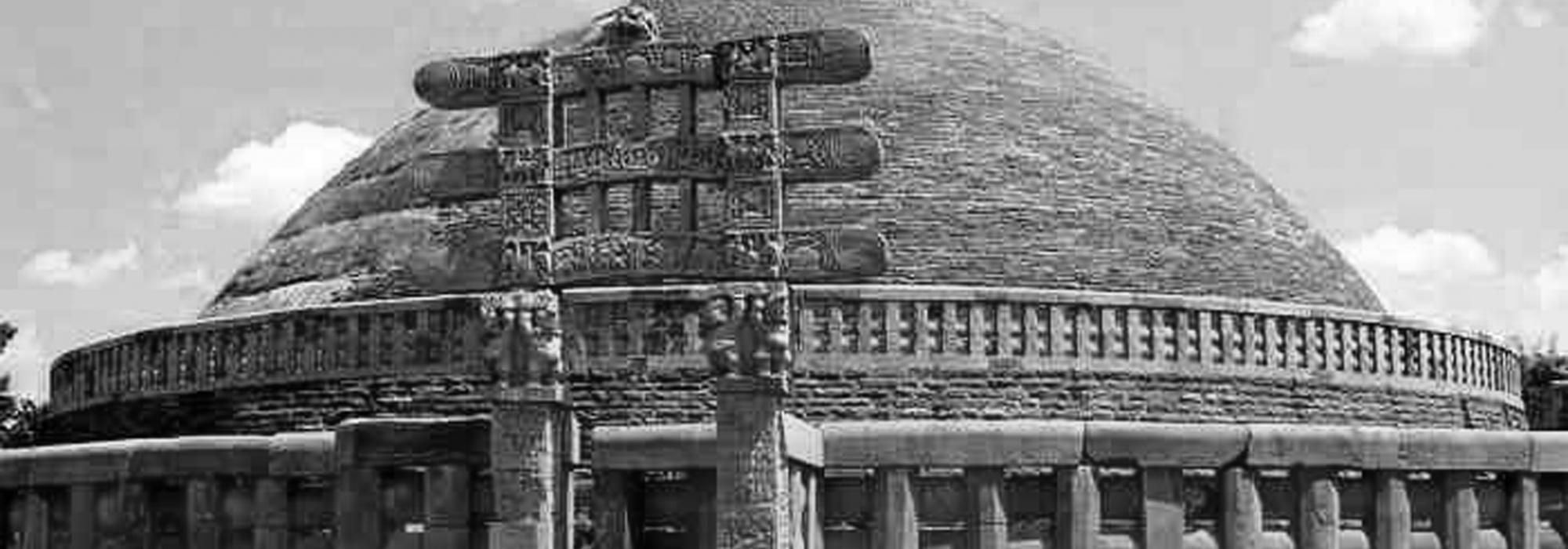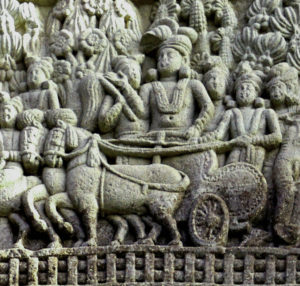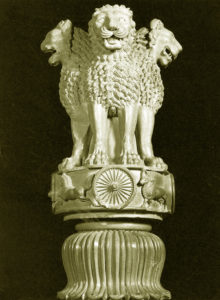A few Chinese travellers like It-sing have recorded that Ashoka was a saṃnyāsi and a Bauddha bhikkhu. They also state that they have seen a statue in this form. There is a system among Buddhists: Anyone can become a saṃnyāsi and can revert to the life of a householder. They can also move to a different āśrama. Fa-hien, Xuanzang (Hiuen Tsang), It-sing, Dharmasvami, and others were Chinese Buddhist travellers who came to India. On numerous occasions, their statements are far from the truth, impelled by their allegiance to their professed faith (Buddhism) or ignorance. Modern scholars have proven this. It is unclear to what extent It-sing’s words are true. If we believe It-sing’s statement that he saw a statue of Ashoka in a bhikkhu’s garb, we must conclude that Ashoka inscribed his dharma-śāsanas setting aside his royal authority; perhaps this motivated him to utter all those words of renunciation, peace, non-violence!
We must greatly value ahiṃsā (non-violence). This should become an ideal for all beings. While the Mahābhārata tenet of ‘अहिंसा परमो धर्मः’ (non-violence is the greatest principle) is true, the latter half of the same verse ‘धर्महिंसा तथैव च’ (as is the violence committed for upholding dharma) is equally true. While non-violence is essential, great value is placed upon the violence that protects dharma. Besides, only the great ṛṣis, ascetics, and yatis who are pure in thought-word-deed can truly practice the tenets of non-violence, non-hatred, universal love, forgiveness, magnanimity, and compassion, not the common folk. It is impossible for kṣatriyas and is inadvisable as well!
In matters of administration, Ashoka trod the path laid down by the arthaśāstras. He divided his administration effectively into different departments comprising three hierarchies – Rajoka, Yuta, and Mahāmātra. The Rajoka was a stationary position (this term is found in the arthaśāstras as well). They are also known as a Rājñikas. The word ‘yuta’ is synonymous with the ‘yuka’ in Kauṭilya’s Arthaśāstra. Mahāmātras occupied the position of the Mahāmātyas. Kauṭilya’s Arthaśāstra designates them as ‘adhyakṣas’ (officers, heads of departments). There were eighteen adhyakṣas such as Aśvādhyakṣa, Sūnādhyakṣa, Sūrādhyakṣa, Gaṇikādhyakṣa, Sūtrādhyakṣa, Sīrādhyakṣa, Ākarakarmāntādhyakṣa, Naukādhyakṣa, and Tulādhyakṣa.
When peace and security have been firmly rooted in a country over several generations, to an extent, it is not wrong to preach the principle of non-violence. But without an ever-vigilant standing army and a ruler who is competent to take all decisions, a cultured and prosperous country will find it tough to survive.
Ashoka sent his own children abroad to spread his chosen faith. Of his numerous children, Kuṇāla, Mahendra (sons), and Saṅghamitrā (daughter), travelled abroad. Ambassadors and envoys of different countries visited his court often. Further, there was a separate department for the propagation of Buddhism in his administrative machinery. Officers across his kingdom were appointed for this purpose. But when we observe that this entire system crumbled within a few years of his death, we clearly recognize the enfeeblement of kṣātra. This rigid proselytizing zeal was unnatural, wasn’t attuned to the sensitivities of the people, and lacked cultural rootedness, resulting in different kinds of calamities.
The path of Ashoka’s compassion is beautiful. We see records of how Ashoka—of his own volition—restrained his impulse to eat meat. We also see his proclamation calling for the protection of commercially useful creatures such as parrots, swans, and peacocks, as well as those like turtles and eagles that weren’t commonly eaten. He classifies them under the non-slaughtering category. At no place should one light a forest fire, and no living being should be sacrificed for the nourishment of another living being. Fishing and meat-eating were prohibited on specific days (this prohibition was enforced by law for fifty-one days in a year). Similarly, castrating bulls and using them as oxen was prohibited. It was forbidden to brand horses.
A criminal facing death sentence was given three days to engage in meditation and reflection to cleanse his mind. However, Ashoka did not rescind capital punishment. After all, the human capacity for cruelty is horrifying and beyond imagination. The wicked must be punished. He is worse than a carnivorous animal. Ordinary citizens will not remain silent if they realize that all this compassion does not carry with it the fear of punishment. When we notice that a major insurrection arose in the wake of Ashoka’s death, we realize where he had slipped and stumbled.
In reality, the modern world places a great value on peace. In accordance with this peace, we need a rules-based system of redress; else mātsyanyāya (big fish eating the small fish) prevails. To put it bluntly, human beings in general are not as cultured and refined as envisioned by Ashoka.
The sculptural artistry during Ashoka’s time was exceptional. Even today we can see this in the numerous stambhas (pillars) as well as in the mūrtis (image, icon, idol) carved on the stambha-śīrśas (head of the pillar). In the Sanchi Museum we find the head of the famous Ashoka Pillar which has four lions, each facing a direction. It has been carved in sandstone and smoothened exquisitely. When the British first saw this sculpture from afar, they thought it was made of metal looking at the light reflecting from it. Fahien and others already praised it profusely. Ashoka had innumerable stupas built (estimated to be 84,000 although the number is disputed). Their remnants are found even today in many places. All the sculptures found in Bharhut and Sanchi were built during the reign of Pushyamitra Shunga. The Sanchi stupa complex is also related to Pushyamitra Shunga. Its doors were built by the Shatavahanas. But the backdrop for this was provided by Ashoka. Thus Ashoka’s brilliance was multifaceted and his accomplishments were numerous. Despite this, he was not able to nurture good successors.
We witness this even in our own age of Gandhi-Nehru: if a person like Nehru could become Gandhi’s successor, it only shows the worth of Gandhian principles. When we observe how Subhash Chandra Bose, Sardar Vallabhbhai Patel, and C Rajagopalachari were pressurized and sidelined, it becomes evident which favourite indulgence Gandhi pandered to.
The philosophy professor at Jodhpur University, M M Kothari has written a valuable book titled The Critic of Gandhi. He has narrated in detail many such instances. Kothari’s observation that whatever Gandhi had done during his passionate youth and had since abandoned, the person named Nehru continued even in his advanced years. Perhaps this element in Nehru was a subject of fascination for Gandhi. This phenomenon is fairly common in society. When we are unable to indulge in or don’t like to pursue certain disagreeable activities and a few in our surroundings indulge in it freely, we tend to develop a kind of forbidden attraction towards them. They act as our ‘negative image’ or ‘alter-ego.’ Even so, we are attracted by their deeds. This is a strange form of mental weakness. Perhaps Gandhi was afflicted with a similar syndrome. But its bitter fruit was disastrous to the nation.
For instance, Vallabhbhai Patel integrated more than five hundred and fifty Princely States into the Indian Union. But the illustrious Nehru who took up the responsibility of just one state, Kashmir, due to his callous negligence, ensured that it has remained a perennial headache. China on one side and Pakistan on the other have illegally occupied parts of Kashmir. As a consequence, strategic points of our country have been lost to foreign hands and have become a perpetual pain.
All of this is an unfortunate result of misplaced arrogance, blind aspiration for peace, and misplaced magnanimity.
Translated from the original Kannada by Sandeep Balakrishna and Hari Ravikumar.


















































Comments